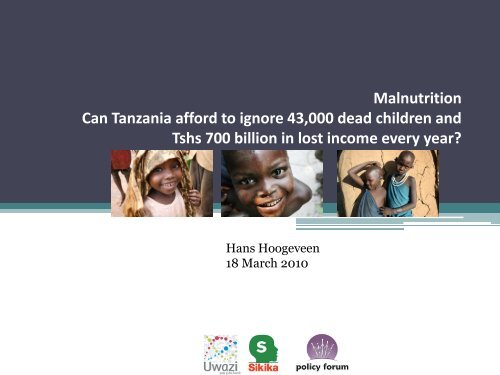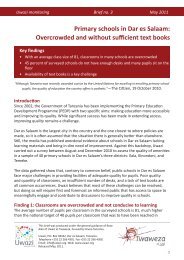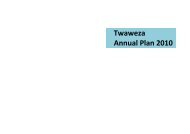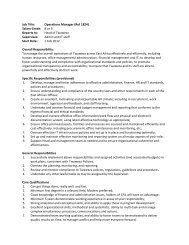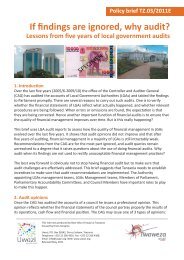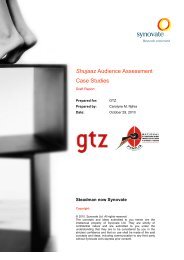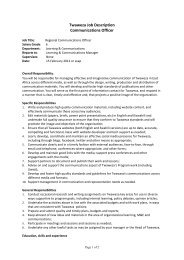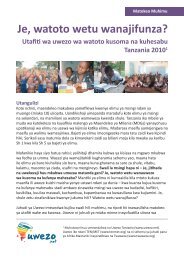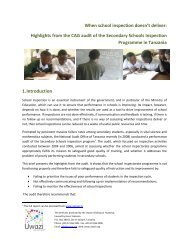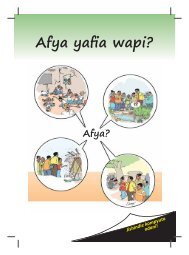Malnutrition ppt presentation - Twaweza.org
Malnutrition ppt presentation - Twaweza.org
Malnutrition ppt presentation - Twaweza.org
- No tags were found...
You also want an ePaper? Increase the reach of your titles
YUMPU automatically turns print PDFs into web optimized ePapers that Google loves.
<strong>Malnutrition</strong><br />
Can Tanzania afford to ignore 43,000 dead children and<br />
Tshs 700 billion in lost income every year?<br />
Hans Hoogeveen<br />
18 March 2010
Number of stunted children in 2000 to 2009<br />
<strong>Malnutrition</strong> is a major concern<br />
Number of stunted children in 2000 to 2009<br />
Source: Uwazi et al. 2010.
Tanzania is 3 rd worst affected country in Africa<br />
Sub-Sahara’s ranking in contribution to world’s stunted children<br />
Country<br />
Global rank<br />
Ethiopia 7<br />
Democratic Republic of Congo 8<br />
Tanzania 10<br />
Egypt 12<br />
Uganda 14<br />
Sudan 15<br />
Kenya 16<br />
Mozambique 20<br />
Madagascar 21<br />
Niger 23<br />
South Africa 24<br />
Source: Uwazi et al. 2010
Number of stunted children in 2000 to 2009<br />
Anemia is also a major concern<br />
Prevalence of anemia in Tanzania in 2004/5<br />
Source: Uwazi et al. 2010.
<strong>Malnutrition</strong> causes many deaths<br />
Cumulative number of children who have died as a result of<br />
malnutrition in Tanzania since 2000<br />
43,000 children are<br />
expected to die of<br />
malnutrition this year.<br />
That is two busses<br />
crashing every day.<br />
Source: Uwazi et al. 2010.
<strong>Malnutrition</strong> causes huge<br />
Estimated Losses due to selected micronutrient efficiencies<br />
economic losses<br />
Estimated Economic Losses ('000 Tshs)<br />
Percent of Total<br />
Perinatal 158,200,913 22%<br />
Children 230,062,042 33%<br />
Adults -- Productivity loss 227,290,570 32%<br />
Adults -- Maternal mortality 6,240,859 1%<br />
Total iron deficiency 621,794,384 88%<br />
Deaths 28,010,952 4.00%<br />
Survivor Lost Productivity 9,005,335 1.30%<br />
Care & Welfare 1,639,208 0.20%<br />
Total folic acid deficiency 38,655,495 5.50%<br />
Vitamin A deficiency 43,947,051 6%<br />
Total 704,396,930 100%<br />
Source: NFFA 2009.<br />
2.6% of GDP is lost<br />
due to<br />
micronutrient<br />
deficiencies
What can be done?<br />
Top 10 of interventions with the highest cost-benefit ratios<br />
Solution<br />
Challenge<br />
1 Micronutrient supplements for children (vitamin A and zinc) <strong>Malnutrition</strong><br />
2 The Doha development agenda Trade<br />
3 Micronutrient fortification (iron and salt iodization) <strong>Malnutrition</strong><br />
4 Expanded immunization coverage for children Diseases<br />
5 Biofortification <strong>Malnutrition</strong><br />
6 Deworming and other nutrition programs at school <strong>Malnutrition</strong> / Education<br />
7 Lowering the price of schooling Education<br />
8 Increase and improve girls’ schooling Women<br />
9 Community-based nutrition promotion <strong>Malnutrition</strong><br />
10 Provide support for women’s reproductive role Women<br />
Source: Copenhagen Consensus 2008. Available at www.copenhagenconsensus.<strong>org</strong>
Fortification is attractive!<br />
Costs and benefits of food fortification in Tanzania<br />
`000 Tshs<br />
Benefits: avoided losses 172,448,000<br />
Costs to Government 5,127,200<br />
Costs to Private sector 13,600,000<br />
Net benefits 153,720,800<br />
Source: NFFA 2009.<br />
Every Tshs 1,000<br />
invested in fortification<br />
yields a return of Tsh<br />
8,000
But it is not a practice in Tanzania<br />
Food fortification in East Africa<br />
Tanzania<br />
Salt<br />
Kenya<br />
Salt, cooking oil, maize flour, wheat flour<br />
Uganda<br />
Cooking oil, maize flour and wheat flour<br />
Zambia<br />
Sugar and plans underway for maize flour<br />
Malawi<br />
Oil, maize flour and trials with sugar<br />
Source: World Bank et al. 2007
Promoting breastfeeding is also a<br />
good option<br />
Number of months of exclusive breastfeeding<br />
Year of<br />
Survey<br />
Median number of months<br />
of exclusive breastfeeding<br />
Kenya 2003 0.5<br />
Tanzania 2004/5 1.8<br />
Eritrea 2002 2.5<br />
Zambia 2007 3.1<br />
Uganda 2006 3.2<br />
Madagascar 2003/4 3.6<br />
Rwanda 2005 5.7<br />
Source: DHS, various years and countries.
With commitment from the nutrition<br />
authorities much can be done<br />
Percent of children aged 6-59 months receiving vitamin A<br />
No major new nutrition<br />
initiatives were taken<br />
after the in introduction<br />
of vitamin A<br />
Source: UNICEF 2009
Focus on implementing solutions<br />
seems to have been lost in research…<br />
2009: Assey V; Peterson S; Kimboka S; Ngemera D; Mgoba C; Ruhiye D; Ndossi G; Greiner T; Tylleskär T Tanzania national survey on<br />
iodine deficiency: impact after twelve years of salt iodation. BMC public health 2009;9():319.<br />
2007: Assey V; Mgoba C; Mlingi N; Sanga A; Ndossi G; Greiner T; Peterson S Remaining challenges in Tanzania's efforts to eliminate<br />
iodine deficiency. Public health nutrition 2007;10(10):1032-8.<br />
2007: Tatala S; Ndossi G; Ash D; Mamiro P Effect of germination of finger millet on nutritional value of foods and effect of food<br />
supplement on nutrition and anaemia status in Tanzanian children. Tanzania health research bulletin 2007;9(2):77-86.<br />
2007: Kass NE; Hyder A; Ajuwon A; Appiah-P; Barsdorf N; Elsayed Dy; Mokhachane M; Mupenda B; Ndebele P; Ndossi G; Sikateyo B;<br />
Tangwa G; Tindana P The structure and function of research ethics committees in Africa: a case study. PLoS medicine 2007;4(1)<br />
2006: Masanja H; Schellenberg J; Mshinda HM; Shekar M; Mugyabuso JK L; Ndossi GD; de Savigny D Vitamin A supplementation in<br />
Tanzania: the impact of a change in programmatic delivery strategy on coverage. BMC health services research 2006;6():142.<br />
2003: Latham M; Ash D; Makola D; Tatala S; Ndossi G; Mehansho H Efficacy trials of a micronutrient dietary supplement in<br />
schoolchildren and pregnant women in Tanzania. Food and nutrition bulletin 2003;24(4 Suppl):S120-8.<br />
2003: Makola D; Ash D; Tatala S; Latham M; Ndossi G; Mehansho H A micronutrient-fortified beverage prevents iron deficiency,<br />
reduces anemia and improves the hemoglobin concentration of pregnant Tanzanian women. The Journal of nutrition<br />
2003;133(5):1339-46.<br />
2003: Ash D; Tatala S; Frongillo E; Ndossi G; Latham M Randomized efficacy trial of a micronutrient-fortified beverage in primary<br />
school children in Tanzania. The American journal of clinical nutrition 2003;77(4):891-8.<br />
2002: Villamor E; Mbise R; Spiegelman D; Hertzmark E; Fataki M; Peterson K; Ndossi G; Fawzi W Vitamin A supplements ameliorate<br />
the adverse effect of HIV-1, malaria, and diarrheal infections on child growth. Pediatrics 2002;109(1):E6.<br />
2001: Lietz G; Henry C J; Mulokozi G; Mugyabuso J K; Ballart A; Ndossi G D; Lorri W; Tomkins A Comparison of the effects of<br />
supplemental red palm oil and sunflower oil on maternal vitamin A status. The American journal of clinical nutrition 2001;74(4):501-9.<br />
2001: Latham M C; Ash D; Ndossi G; Mehansho H; Tatala S Micronutrient dietary supplements--a new fourth approach. Archivos<br />
latinoamericanos de nutrición 2001;51(1 Suppl 1):37-41.<br />
2000: Fawzi W W; Mbise R; Spiegelman D; Fataki M; Hertzmark E; Ndossi G Vitamin A supplements and diarrheal and respiratory tract<br />
infections among children in Dar es Salaam, Tanzania. The Journal of pediatrics 2000;137(5):660-7.<br />
2000: Villamor E; Mbise R; Spiegelman D; Ndossi G; Fawzi W W Vitamin A supplementation and other predictors of anemia among<br />
children from Dar Es Salaam, Tanzania. The American journal of tropical medicine and hygiene 2000;62(5):590-7.
…and in meetings<br />
November 2002: The 36 th Regional Health Ministers conference (Uganda): Tanzania agrees on “Enhanced Implementation and Coordination of Food Fortification Interventions both at the Regional and National<br />
Levels”<br />
March 2003: The National Food Fortification Alliance (NFFA) is established<br />
March 2004: 1 st Regional Food Fortification Workshop (Zambia) to set “Regional Approaches for Joint Food Fortification Activities in ECSA”<br />
July 2004: Tanzanian delegates participate in the 2nd Regional Food Fortification Workshop (South Africa) in “Preparing for Optimal Implementation and Use of Food Fortification for the Reduction of<br />
Micronutrient <strong>Malnutrition</strong>”<br />
November 2004: 40 th Regional Health Ministers’ Conference (Zimbabwe): Tanzania adopts food fortification as a strategy to Prevent and Control Vitamin and Mineral Deficiencies<br />
May 2005: TBS and TFNC participate in the ECSA training workshop for laboratory personnel (South Africa)<br />
August, 2005: Tanzanian delegates participate in the 3 rd Regional Food Fortification Workshop (Uganda) on “Creating Good Partnerships to Accelerate Progress”<br />
March 2007: ECSA workshop “Harmonization of Regional Regulations and Standards of Fortified Foods” (Arusha) to develop regional guidelines and standards for a safe and efficacious fortification program.<br />
March 2007: ECSA workshop “Strengthening Quality Control and Inspection of Fortified Foods” (Arusha) to discuss ways of strengthening quality control throughout the production and distribution chain of<br />
fortified foods.<br />
February 2008: The 46 th Regional Health Ministers’ Conference (Seychelles): Tanzania agrees to immediately adopt and support implementation of ECSA food fortification guidelines by end of 2009, and increase<br />
financial resources by at least 20% within the next two years for nutrition with a focus on micronutrients interventions<br />
March, 2008: 2 nd ECSA Laboratory Proficiency Testing Review Meeting (Malawi) to introduce the Manual of Laboratory Methods for fortified foods<br />
October, 2008: 3 rd ECSA Laboratory Proficiency Testing Review Meeting (Kenya) to receive updates on analytical assays in support of food fortification programs.<br />
November, 2008: 1 st African Flour Fortification Initiative (Arusha): MoHSW, TFNC, TBS, TFDA and MoITM commit themselves personally and institutionally to accelerate action towards successful flour<br />
fortification.<br />
February, 2009: SAFO Workshop: “Towards a Sustainable Cost-Effective Food Fortification Partnership for Tanzania” - mutual understanding about stakeholders capacities, engagement opportunities, publicprivate<br />
partnership set-up and implementation.<br />
February, 2009: SAFO Expert Workshop: “Standard Setting in Food Fortification in Tanzania” - current strengths in Tanzanian efforts towards standard setting for food fortification, international experiences in<br />
standard setting for food fortification, and discussion of concrete and specific issues around selected standards.<br />
February-April, 2009: Two consultants begin drafting the Fortification Action Plan together with stakeholders.<br />
March 2009: 48 th Regional Health Ministers’ Conference (Swaziland): Tanzania agrees to implement key high impact health and nutrition interventions such as food fortification.<br />
May, 2009: Technical Stakeholders Review: discusses the draft Action Plan and decides on an appropriate programme management structure, approach and schedule for the implementation of the Action Plan.<br />
September, 2009: High Level Forum on Food Fortification: Participants agree to adopt the Food Fortification Action Plan, promise to take ownership and assume responsibility for the implementation of the Plan<br />
September, 2009: 4 th Regional Food Fortification Workshop “Consolidating Roles of the Public Sector to Enhance Private Sector Involvement in Food Fortification” (Kenya): countries share experiences and lessons<br />
learnt in start up and implementation of national fortification programmes and identify best practices 2000;62(5):590-7.
Focus on solutions:<br />
reduce malnutrition by ...<br />
• Introducing fortified foods<br />
▫ Large scale millers are ready<br />
▫ Main obstacle is setting a standard<br />
• Promoting exclusive breast feeding<br />
Achieving these objectives<br />
requires leadership from the<br />
nutrition authorities:<br />
• TFNC<br />
• Ministry of Health<br />
•TFDA<br />
• TBS


